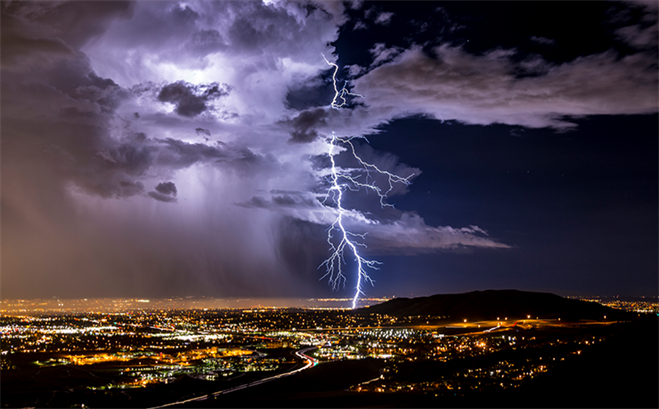Lightning Strike Causes Six-Alarm Fire
April 05, 2023 by Kate Nadolski

What started off as a warm summer day in August, ended in a series of emergencies when severe thunderstorms with heavy lightning moved in over Marion County, Oregon.
Small fires caused by lightning were called in by residents throughout the county, and dispatchers with the Marion Area Multi-Agency Emergency Telecommunications Center (METCOM) sent responses as needed.
"We had small fires throughout several areas of the county," METCOM communication specialist Loren Hall said. "Lightning-caused fires are a relatively rare event for us."
However, on that particular day, lightning fires were a major event for public safety personnel throughout the county.
At 4:47 p.m., a call came in regarding a house fire in a gated community full of large homes. Hall knew right away this wasn't going to be a small fire and getting the proper response to the fire could be an issue due to the concurrent emergencies taking place at the time.
According to Hall, just prior to the large house fire, first responders were called to the scene of a smaller house fire and motor vehicle accident with injuries. That meant the normal response that would have been sent to the large house fire was already committed to serving other emergency situations and completely unavailable to respond.
"Knowing that the first alarm assignment was going to be delayed, our fire chief made the decision to escalate the call to a second and third alarm without even being on the scene," Hall said.
When the first unit arrived on the scene at 5:03 p.m., flames were reported coming from the second story attic roof. Less than 30 minutes later, the house fire went from bad to worse when a ceiling collapsed on an interior attack crew, which engulfed this crew in the attic fire. That's when a firefighter outside of the structure called a MAYDAY over the radio thinking firefighters were in dire need of help inside the burning house.
"The members of the interior crew were able to exit the structure, and the worst injury sustained was a fractured ankle by one of the firefighters as he ran down the stairs to get away from the fire," Hall said. "Thankfully, no one was severely injured, but that fact was unknown at the time the MAYDAY was called."
As the fire continued to burn, it escalated to a sixth alarm and a command-level fire officer came into METCOM to assist with coordinating a regional-level response so that other areas dispatched by METCOM did not go uncovered.
"The command officer works on making sure additional areas get coverage and interfaces with command to determine unique needs on the scene," Hall said. "This helps all of the needs of the emergency response to be met while dispatchers can then concentrate on radio traffic."
The fire resulted in 44 apparatus being dispatched, which included 18 engines, 15 water tenders, two wildland engines, six ambulances, two support trucks, and one rehab unit along with six chief officers. Approximately 125 firefighters were also on the scene.
The house was a total loss as a result of the fire, but there were no severe injuries had by the occupants of the house or fire crews.
To deal with an emergency of this size, operations were adjusted at the communication center, according to Hall. Work loads were reassigned and a second dispatcher was brought in to work on the house fire call for service. That provided the primary dispatcher with the ability to concentrate on monitoring fire ground activities and interfacing with command. The second dispatcher was able to take requests from the primary dispatcher and coordinate or find the extra resources needed, dispatch the additional alarms, and coordinate units en route to the fire.
Transitioning into team dispatch mode was done seamlessly as a result of Enterprise CAD (computer aided dispatch) used by METCOM.
Information was shared across physical dispatch positions so all individuals involved in the management of the incident were able to see what each other was doing and assist in fulfilling requests for resources.
"CAD allows for every person to see what's happening globally," Hall said. "With the use of CAD features, such as the event ticker, the dispatcher is able to see activity anywhere in the system regardless of their current assignment. Those types of CAD features allow dispatchers to see things in real time and maintain a higher level of situational awareness and respond faster to dynamic events as they unfold."